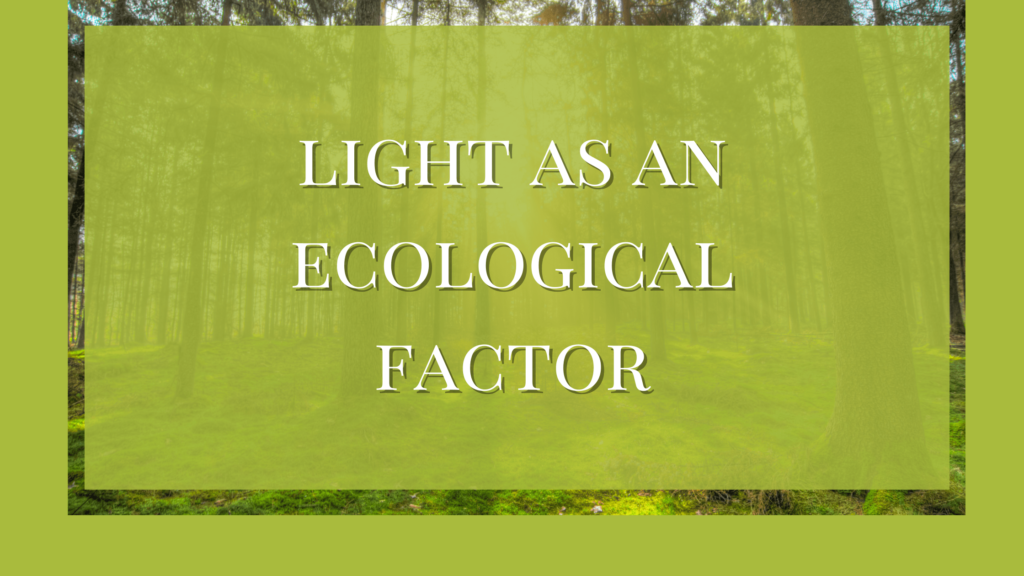Light as an ecological factor is physiologically important to plants. The synthesis of food by green plants depends on the availability and intensity of light. Plants and plankton use only about 3% of the total solar radiation that falls on the earth. This energy is used for primary productivity.
Due to variations in other climatic factors such as water availability and air quality, light intensity shows major variations. This in turn will affect the primary productivity of the plants. Here are some of the major effects of light as an ecological factor.
Availability of Light
The sun is the only source of light. The amount of light that falls on the earth varies according to the season, altitude, atmospheric conditions, etc. At the equator region, light intensity is the greatest. If the atmospheric humidity is higher, light intensity decreases. This is due to the effect of heavy clouds and fog.
Submerged water plants only get very weak light since the water layer present over them reduces the light intensity. Hence plants in deeper regions of water are unable to carry out photosynthesis.
The different colors of ordinary white light penetrate different levels of water. Since the violet rays have the maximum energy, they penetrate the deepest, and red light having low energy penetrates only the superficial layer.
Hence in the ocean, green algae (red light absorbing) are seen in the superficial layer and brown and red algae are seen in the middle and deeper layers respectively.
In thick forests, the penetration of light to the floor becomes difficult and hence only shade-loving plants (sciophytes) develop there. The pants of such shaded habitats of any adaptations are known for displaying their foliage.
In many cases the leaves are arranged in a mosaic fashion which reduces the overlapping of the leaves or the leaves are arranged in a rosette manner. In mango plants, the branches become progressively shorter towards the apex. This arrangement makes all the branches get the maximum light possible. Weak-stem plants like twiners and climbers expose their leaves to maximum sunlight.
Effect of Light as an Ecological Factor
Plants that grow in shade or darkness produce the maximum amount of growth-promoting substances like auxins. So that the plants of such habitat can have more elongation of the internodes. When the light intensity is greater, the amount of auxins produced will be less and thus those plants will have shorter internodes. Such plants on the whole will be stunted in growth.
In angiosperms, the chlorophyll formation increases with the increase of light. Thus light is essential for the formation of chloroplast and its functions. This synthesis of food through photosynthesis is the only source of energy for both plants and animals. Light also acts as a factor in transpiration.
Light influences different quantities of oxygen production on two sides of the plant organ. The side of the plant exposed to the light shows reduced oxygen production and their growth may be retarded. But the opposite region produces more oxygen to increase its growth.
Owing to the difference in growth of the two sides, the organ bends towards the light (phototropism). Thus the different light intensities have a profound influence on the distribution and morphological makeup of the plants/
Light affects the internal structure of plants, especially leaves. String light increases palisade development. In strong light, leaves often develop two or more layers of palisade. Since the palisade is vertical, the chloroplast within the cells moves up and down at low and high light intensities respectively.
The response of plants to a particular day length of light for their growth and fruit formation is called photoperiodism. And this optimum light is called photoperiod. Controlling the duration of the daylight period can induce or prevent flowering.
Depending on the duration of the photoperiod. There are short-day plants and long-day plants. Short-day plants need only a short period of light, below 12 hours and long-day plants need a longer period or more than 12 hours of light for flowering.
Thus climatic factors are of supreme importance in determining the general characteristics of vegetation over wide areas.
References
- Shukla, R.S. and Chandel, P.S. (2001) Plant Ecology. S. Chand and Company Ltd., New Delhi.
- Verma, P.S., Agarwal, V.K. (1999). Cell Biology Genetics Molecular Biology Evolution and Ecology. New Delhi: S.Chand Co.(Pvt) Ltd.
Additional Reading
- Climatic Factors: Atmospheric Moisture
- Temperature As an Ecological Factor
- Edaphic Factors or Soil Factors




